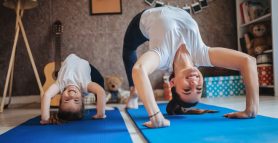7 ways to help your kids get exercise indoors
For many parents, getting kids to exercise when they can't go outside is a challenge. But there are fun ways to help your children stay active indoors.

Happy, healthy kids need at least 60 minutes of physical activity every day, according to the American Institute for Cancer Research.
From your child’s coordination and muscle development to ensuring he or she stays a healthy weight later in life, daily exercise is essential, says Whittney Thoman, a senior exercise physiologist in MD Anderson’s Cancer Prevention Center.
We know getting kids active when they are stuck indoors is a challenge. Don't panic, there are fun ways to get your children moving inside.
Here are Thoman's tips for keeping kids active when they can't go outside.
Turn chores into challenges. Household chores are a great way to get your kids up and moving. Ask them how fast they can clean up their room, or if they think they can collect all the trash in the house in less than a minute, Thoman says. “Kids really respond to games and challenges,” she says. Turning every day activities into contests and games makes them more engaging and less like chores.
Create indoor activity stations. Find areas in your house and label each with various moves or exercises like jumping jacks, hops, planking, push-ups or squats. Set a timer and do a circuit together. You also could use painters tape to create indoor hop scotch or create home bowling with plastic cups and a tennis ball or baseball.
Train alongside your kids. Children often do what their parents do, not as they say. “If you’re sitting on the couch and watching TV, they’re going to follow your example,” Thoman says. Instead, include your kids in your exercise. When you do pushups or sit-ups, ask your kids to count and cheer you on. Then, do the same for them. Or put on an exercise video that you and your kids can do together. “You’ll keep them active while demonstrating that exercise is important to you.”
Dance with your kids. Search online for some dance moves to learn together with your kids. There are so many to select from. Have your little one pick a dance move so they get a chance to be in charge. You also can search for kid exercise videos like yoga.
Build forts. Transform your couch into a fortress of pillows and blankets, or turn your rug into a putt-putt course with cups. “Your kids don’t have to be running for it to qualify as physical activity,” Thoman says. “They just need to be up and moving around.”
Try old-school games. Search online for “minute to win it” games. You’ll find dozens of fun, simple activities involving household items. One example for small children: Tie a carrot to their belt using a piece of string, and challenge them to lower it into a mason jar. It’s like doing squats, but more fun. “These types of games are entertaining and have health benefits,” Thoman says.
Enlist their help in the kitchen. Whether you’re cooking a meal, putting away the groceries or emptying the dishwasher, anything you do in the kitchen can serve as activity for your tyke. Ask your child to help you pull out the pots and pans, or to sort the pantry into alphabetical order. You can turn the time when they’d be sitting and watching TV into active time.
Remember, keep it fun
Motivating kids to exercise can sometimes seem more difficult than finding activities, Thoman says.
“Whatever you do, don’t force them,” she says. You don’t want to make exercise seem like a punishment, or something they dread.
Try this: Talk enthusiastically about the fun activity you have planned for later in the day—whether it’s a new trying a new activity or some household chores.
"If you talk like it’s the most fun thing in the world, and you give them time to get excited for it, that helps drive their interest,” she says.
Also, give them choices. If you ask your children whether they want to make forts or do an exercise video, it usually won’t occur to them that doing neither is an option.
Finally, after your kids have gotten some exercise, say things like, “Wasn’t that fun to run around?” or “I feel so great when I exercise.” This will reinforce the idea that physical activity is something enjoyable.
Find COVID-19 resources and learn how MD Anderson is responding to the pandemic.
This article was last updated on April 15, 2020.





